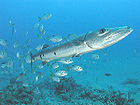- Sustainable yield in fisheries
-
The sustainable yield of natural capital is the ecological yield that can be extracted without reducing the base of capital itself, i.e. the surplus required to maintain ecosystem services at the same or increasing level over time. This yield usually varies over time with the needs of the ecosystem to maintain itself, e.g. a forest that has recently suffered a blight or flooding or fire will require more of its own ecological yield to sustain and re-establish a mature forest. While doing so, the sustainable yield may be much less.
In fisheries, the basic natural capital, or virgin population, must decrease with extraction. At the same time productivity increases. Hence, sustainable yield would be within the range in which the natural capital together with its production are able to provide satisfactory yield. It may be very difficult to quantify sustainable yield, because every dynamic ecological conditions and other factors not related to harvesting induce changes and fluctuations in both, the natural capital and its productivity.
Contents
Maximum sustainable yield
In population ecology and economics, maximum sustainable yield or MSY is, theoretically, the largest yield/catch that can be taken from a species' stock over an indefinite period. Under the assumption of logistic growth, the MSY will be exactly at half the carrying capacity of a species, as this is the stage at when population growth is highest. The maximum sustainable yield is usually higher than the optimum sustainable yield.
This logistic model of growth is produced by a population introduced to a new habitat or with very poor numbers going through a lag phase of slow growth at first. Once it reaches a foothold population it will go through a rapid growth rate that will start to level off once the species approaches carrying capacity. The idea of maximum sustained yield is to decrease population density to the point of highest growth rate possible. This changes the number of the population, but the new number can be maintained indefinitely, ideally.
In most fisheries, the population has been decreased so significantly from their native populations, that the only way to increase production is to decrease production, and wait for populations to recover. Establishing limits is a perennial difficulty.
MSY is extensively used for fisheries management. Unlike Schaefer's logistic model, MSY in most modern fisheries models occurs at around 30% of the unexploited population size. This fraction differs among populations depending on the life history of the species and the age-specific selectivity of the fishing method.
Unfortunately errors in estimating the population dynamics of a species can lead to setting the maximum sustainable yield too high (or too low). An example of this was the New Zealand Orange roughy fishery. Early quotas were based on an assumption that the orange roughy had a fairly short lifespan and bred relatively quickly. However, it was later discovered that the orange roughy lived a long time and had bred slowly (~30 years). By this stage stocks had been largely depleted.
Optimum sustainable yield
In population ecology and economics, optimum sustainable yield is the level of effort (LOE) that maximizes the difference between total revenue and total cost. Or, where marginal revenue equals marginal cost. This level of effort maximizes the economic profit, or rent, of the resource being utilized. It usually corresponds to an effort level lower than that of maximum sustainable yield.
In environmental science, optimum sustainable yield is the largest economical yield of a renewable resource achievable over a long time period without decreasing the ability of the population or its environment to support the continuation of this level of yield.
Annual Sustainable Yield
Annual Sustainable Yield (ASY) is defined as biomass that can be harvested from a fish population each year without resulting in a decline. ASY is dynamic and is adjusted based on population levels and performance of previous years fisheries.
See also
- Sustainable yield
- Sustainable fisheries
- Population dynamics of fisheries
References
- The Sunken Billions: The Economic Justification for Fisheries Reform World Bank Publications, Washington DC, 2009, ISBN: 978-0-8213-7790-1
- Hart, Paul J B and Reynolds, John D (2002) Handbook of Fish Biology and Fisheries, Chapter 8, The economics of fisheries. Blackwell Publishing. ISBN 063206482X
- Glossary of Environment Statistics, Studies in Methods Series F, No. 67, United Nations, New York, 1997.
- FAO: Fisheries glossary
- NOAA: Fisheries glossary
External links
Categories:- Fisheries science
- Conservation
- Economics terminology
- Renewable resources
Wikimedia Foundation. 2010.


